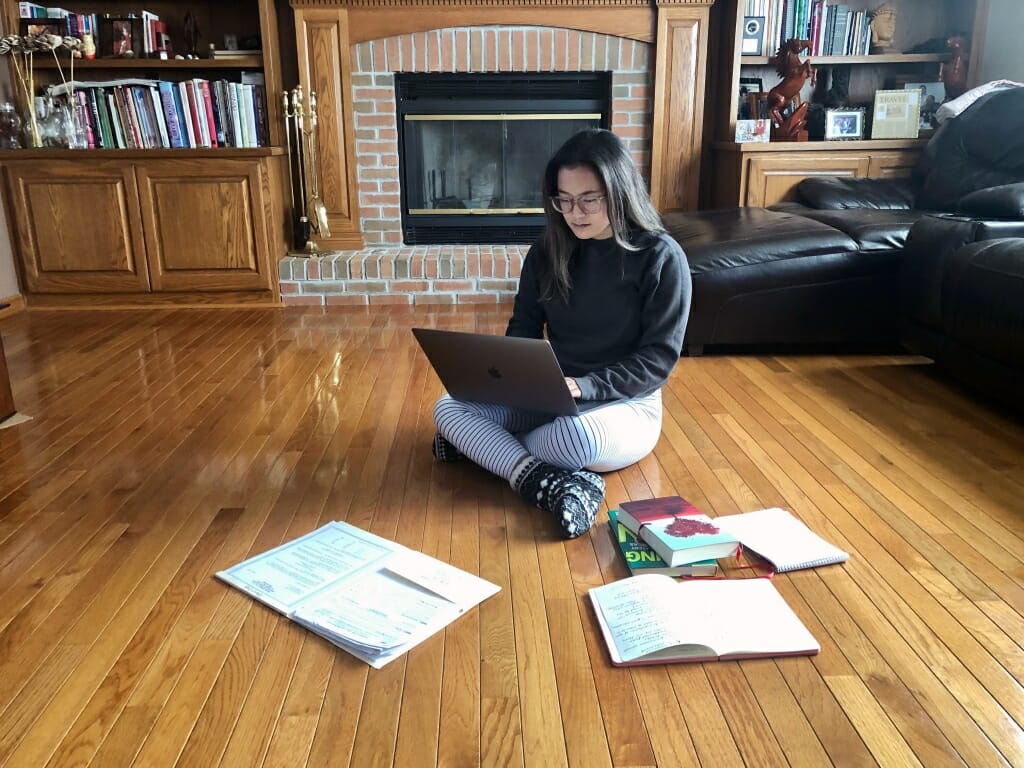Student-to-student: What online learning taught me about staying connected

Participating in class is much different now due to the COVID-19 pandemic. My courses are conducted through video. My notebooks are sprawled out across my living room floor. My new dress code has become the same outfit I slept in last night and fuzzy slippers.
Editor’s note: Kayla Huynh is a senior journalism student from Bloomington, Illinois. She writes for University Communications and is the communications director for the Senior Class Office.
Each week, I roll out of bed and get ready for my first class of the day, just as I’ve done for the past four years of college.
It’s no longer Vilas Hall or Humanities that I head to, though. Instead, my normal 6-minute walk to class has been replaced by a mere four steps into my mom’s office across the hall. With all UW–Madison courses shifted to online learning, this is what my day-to-day routine looks like.
I wasn’t expecting it to be like this. Upon leaving for spring break, I thought I’d eventually come back to a busy University Avenue, a Bascom Hill filled with students basking in the sun, pounds of Babcock ice cream that I can’t resist. For now, I’m studying from my childhood bedroom in Illinois, just three hours from campus but what feels like worlds away from my friends and classmates.
I’ll admit: I didn’t want to complete my studies virtually. I was resistant to the change at first. After all, this wasn’t the senior semester I had envisioned or the final undergraduate days that I had so long dreamed of. What would learning look like in an online setting? How would we be able to interact without seeing one another in-person? What will people think of me when they see I’ve been wearing the same shirt for a week now?
I’m sure most students and faculty initially had the same thoughts, too. Still, we’re giving it a try. And for the most part, it really works.
Though online classes certainly aren’t the same as those that were once in-person, we’ve all learned to make the most of what we have. In the face of adversity, we’ve chosen to keep pushing forward — even when our peers and professors are miles apart.
On a single video call, I can see the faces of classmates who may be in a different state or time zone than me. The first week took some adjusting: “Can everyone please mute their mics?” But with some quick changes and student feedback, the instructors have adapted their classes, smoothing out the bumps with care.
At noon, my professor’s voice booms out of my laptop speaker, where I learn about 19th century science in a pre-recorded lecture. At 2:30 p.m., I hop onto a live-stream discussion to learn about John Dewey and Walter Lippmann. At 4:30 p.m., I listen to guest speakers talk about social justice and politics.
That’s the bright side of technology — it can bring us together in times like these. While physical distance and a computer screen may separate us from one another, we can all make an effort to come together virtually. With the help of video conferences and discussion posts and emails, we’re doing just that. We’re trying our best. And now, we’re even more empathetic and supportive of each other than ever before.
One of my professors cheers when we successfully navigate the day’s discussion through Blackboard. She tells us to call her if there’s anything we need. Another checks in on my class to make sure we’re all doing OK. He reminds us these virtual classes not only give us the opportunity to learn but also to have company in our own isolation. He reminds us that although everything has changed, our online courses can offer us a sense of normalcy. Even through the awkward silences, muted mics and misconnections, it reminds us that we’re all tied together in spite of the firewalls between us.
They may be different than before, but our daily classes now give us something to look forward to. A glowing screen is now a beacon of hope. Our keyboard is now a place to express our thoughts. Vilas Hall is now my mom’s office, my professor’s basement or my classmate’s living room. We can collectively learn and think and talk with just a few clicks of a mouse and hundreds of little pixels.
Despite its challenges, there’s still an opportunity for us to grow as students, and more importantly, to learn from one another. We’ll always have a campus home to eventually come back to just months down the road. In this way, it’s like we’re picking up right where we left off.
We’ll continue to go to office hours to talk about life and attend class to learn about the world, just as we would have weeks ago. This time, we’ll all be in our respective homes — but luckily, through Wi-Fi, video calls and a few assigned readings, we can remain connected. It reminds us that although we’re not physically together, we’re certainly not alone.
Tags: coronavirus, courses, covid-19, faculty and staff, learning, student life, students
